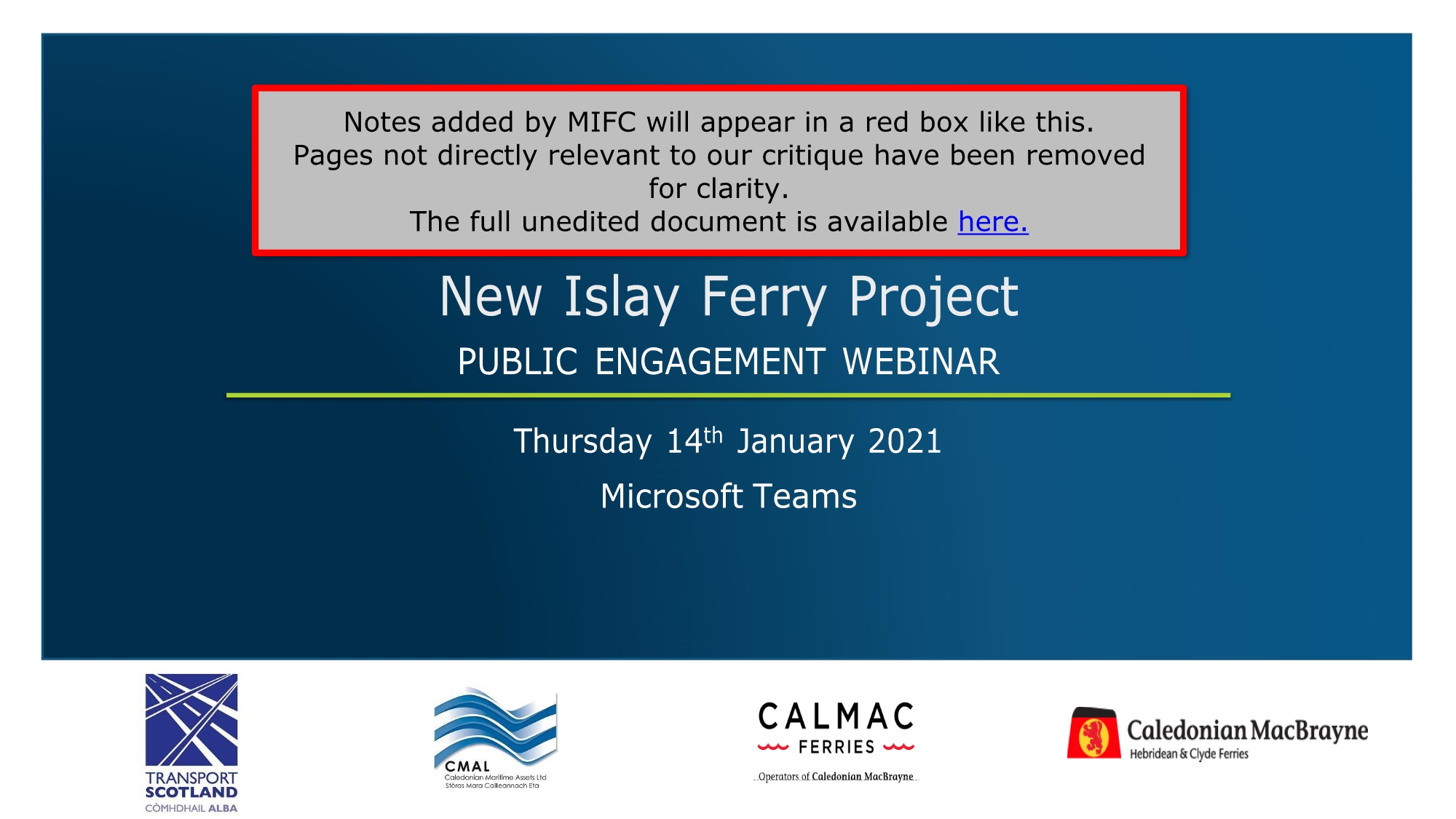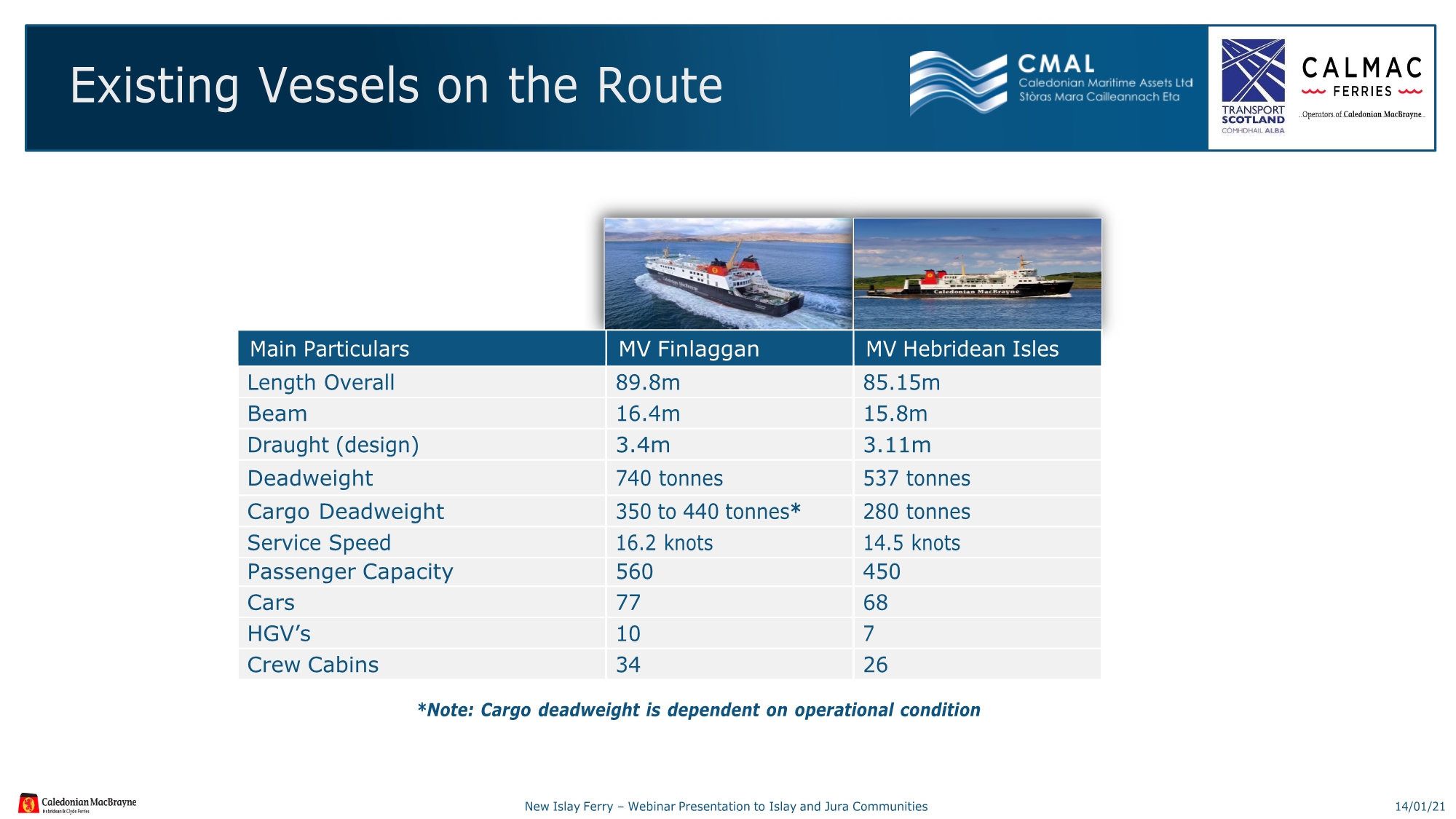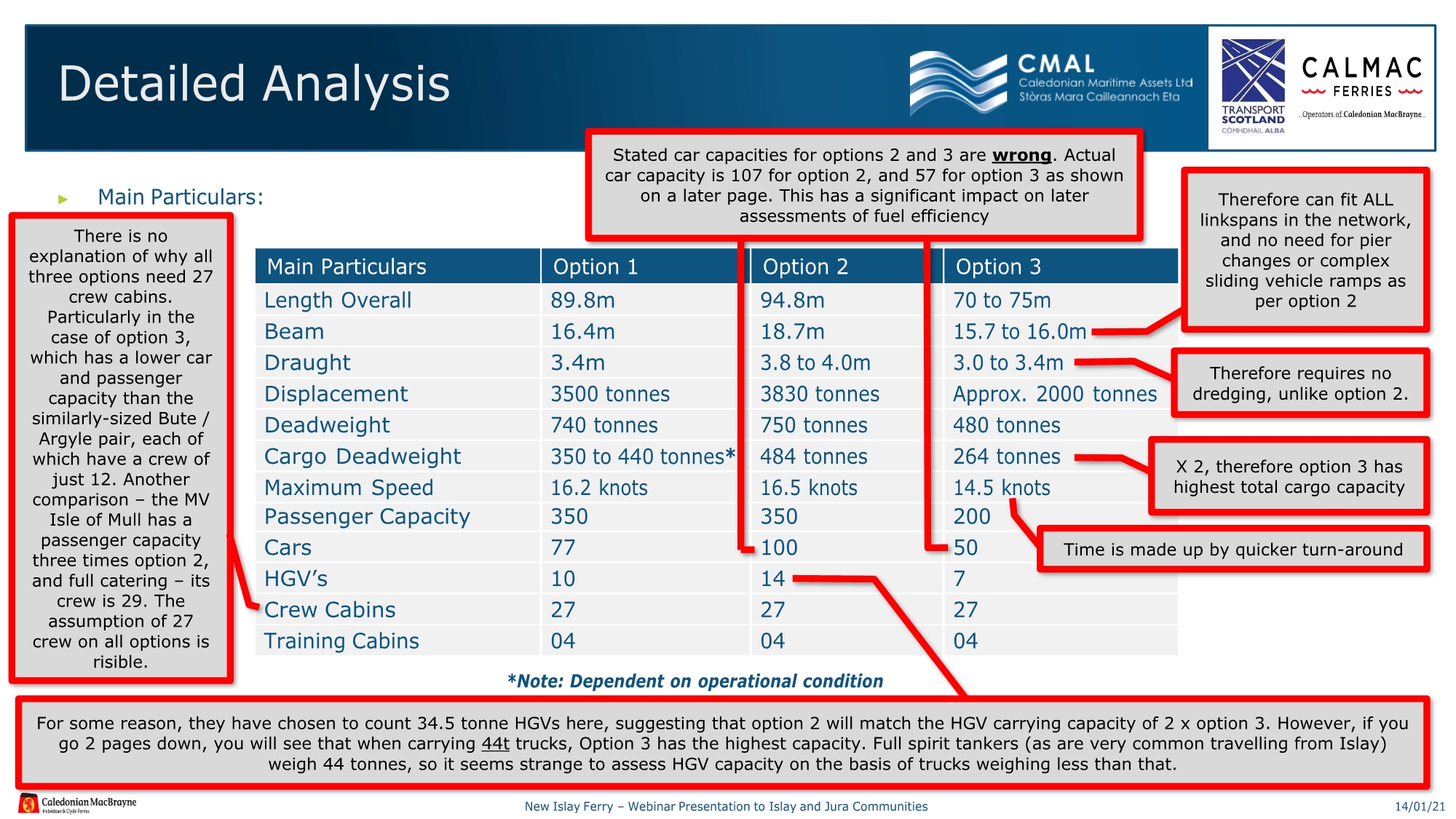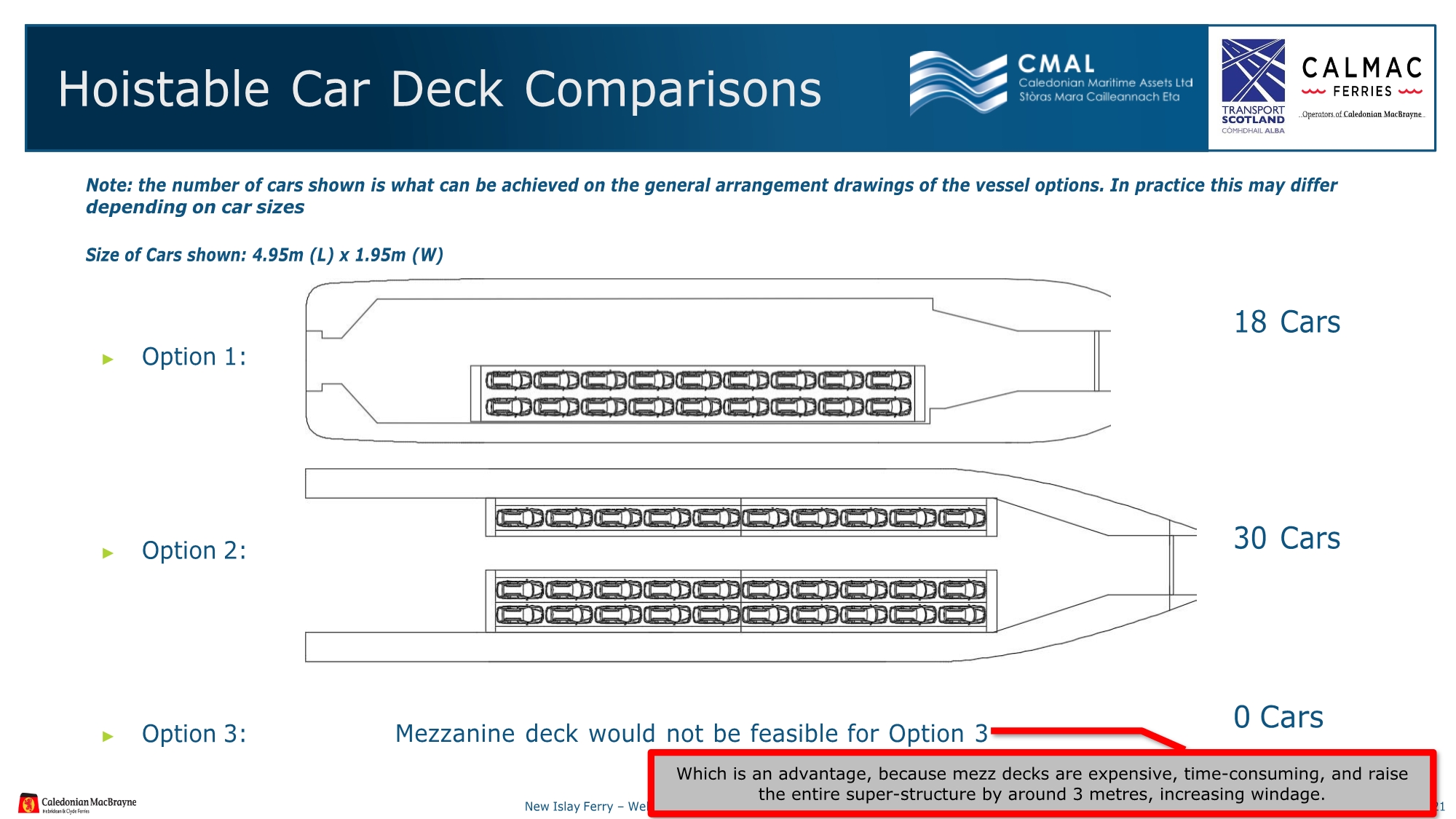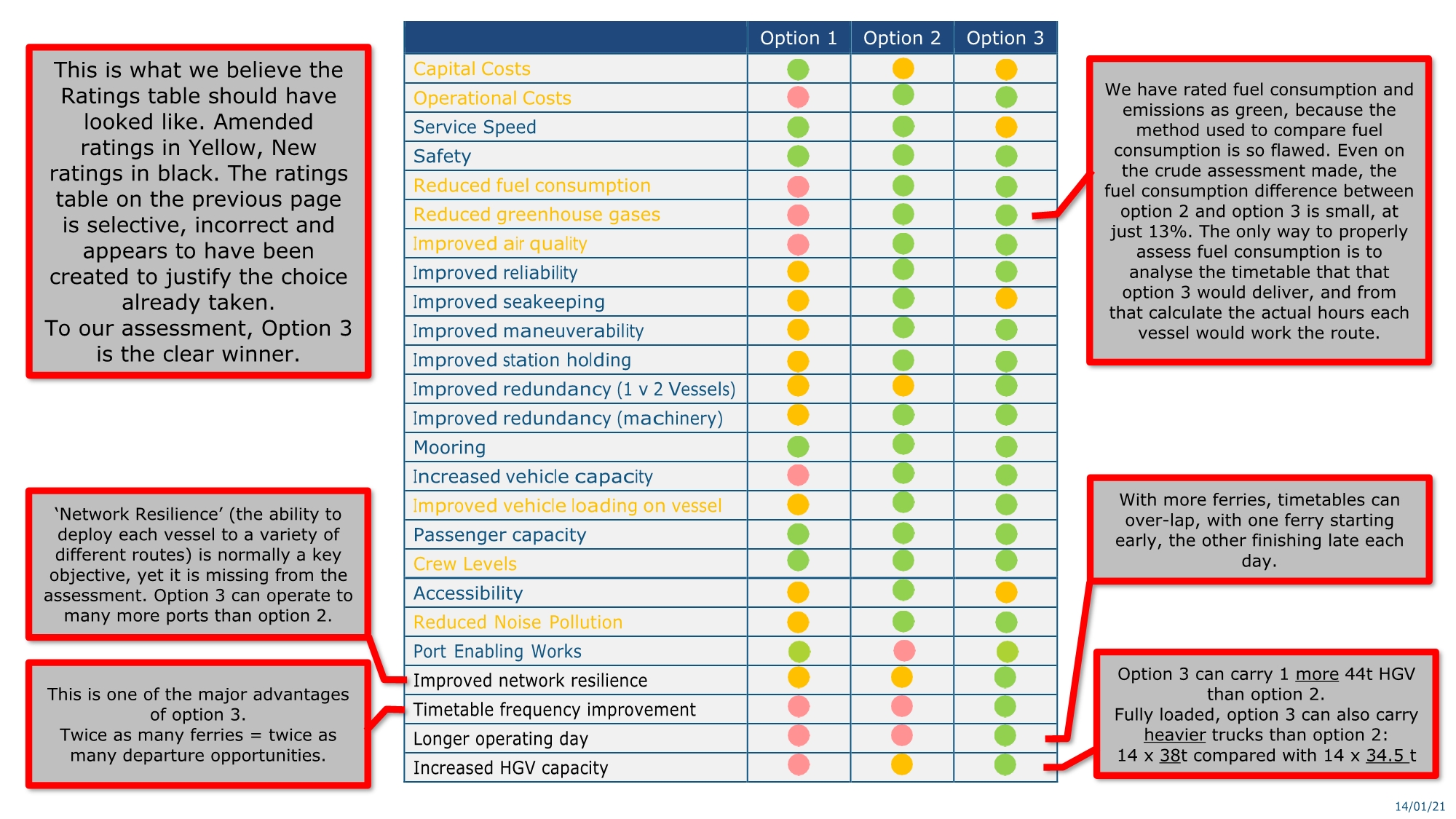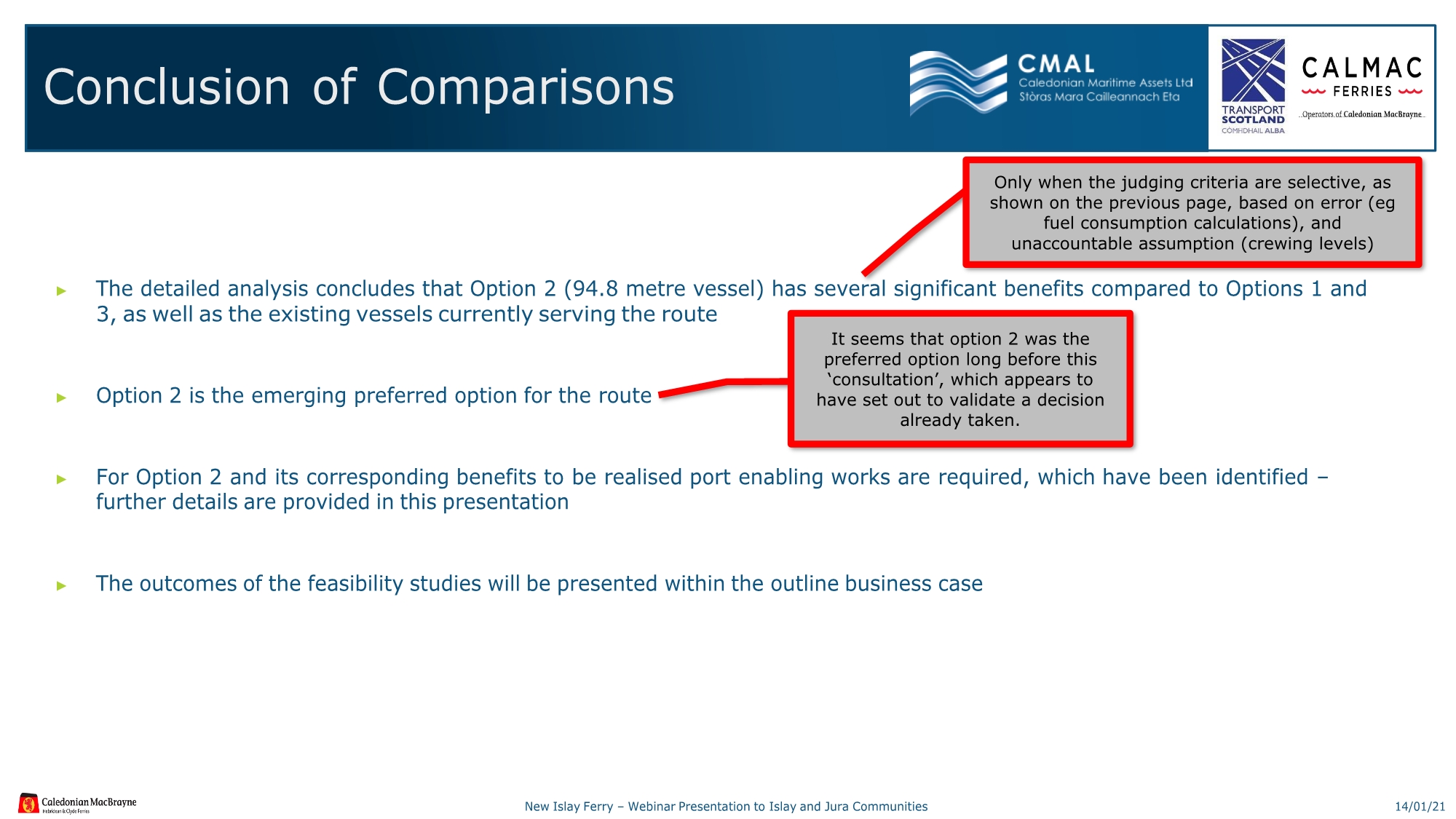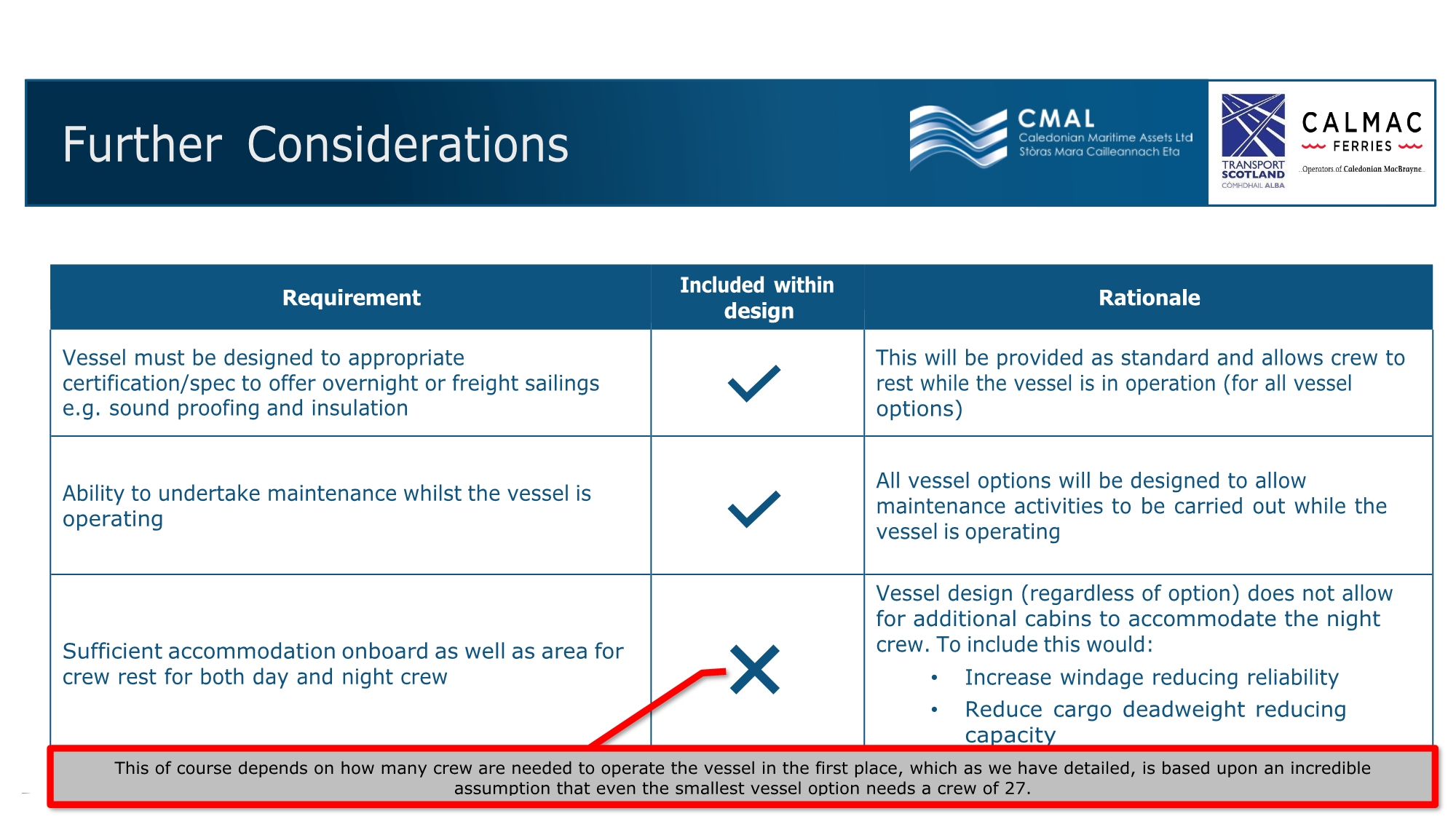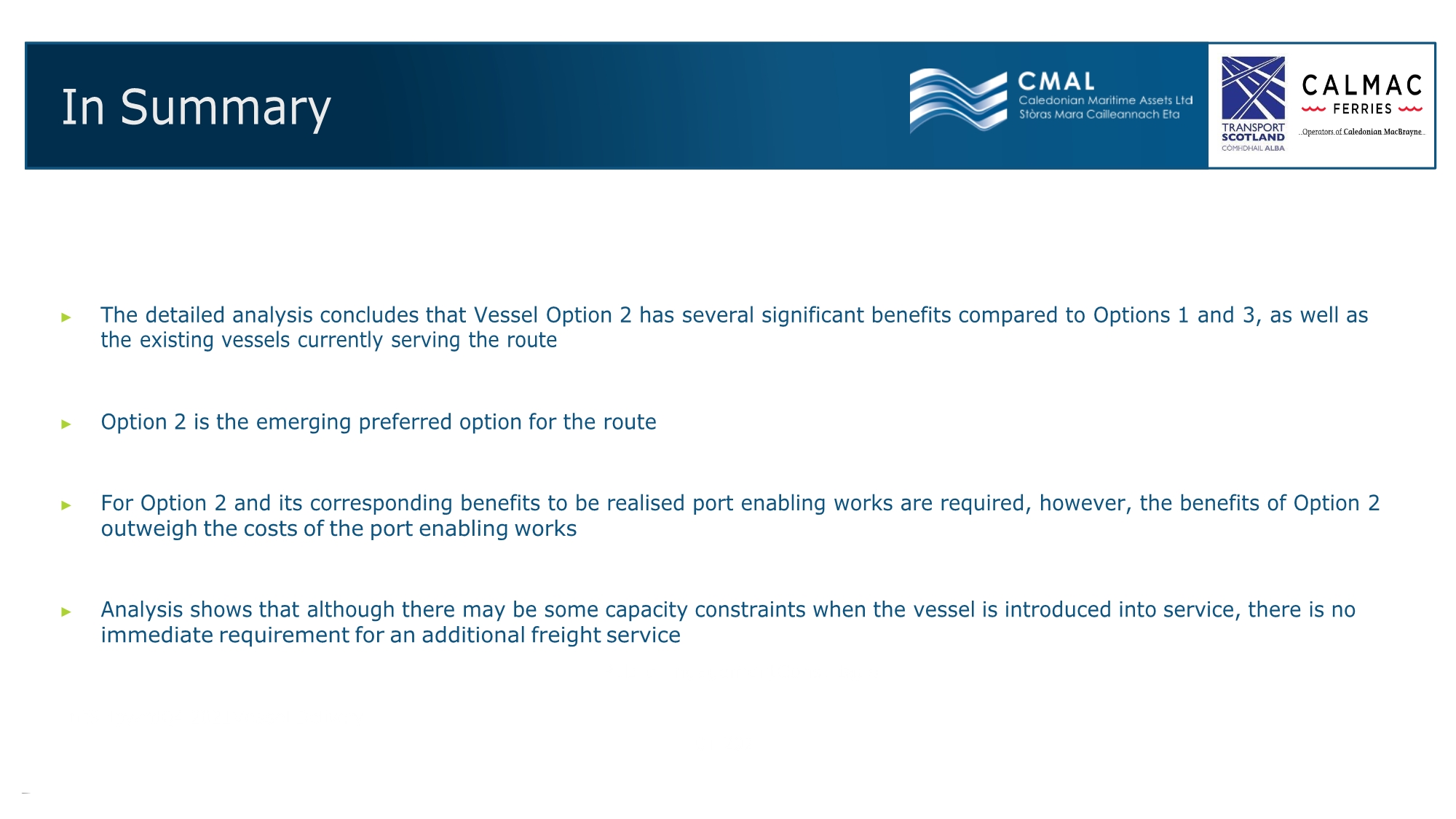April 2022
Last month, CMAL announced that the Turkish shipyard Cemre had been awarded a contract to build a pair of new ferries for Islay. Each New Islay Ferry (NIF) is understood to cost £52.5 million, with a further £17 million being spent on dredging and pier upgrades to accommodate them. The total bill for these two vessels will be £122 million.

MIFC have taken a close interest in the NIF procurement process, in part because we are expected to be next in line for major vessel replacement, and in part because our efforts to persuade CMAL to buy a second-hand ferry for Mull were active at the same time.
What we have discovered however, is that CMAL’s decision-making is deeply flawed; that they have dogmatically obstructed innovation; and that their ‘consultation’ has been deceptive, biased and pre-judged.
We have split this into two parts. In this first part, we’ll give a critique of the process and decisions made. Part two will be released in the week beginning 18th April, and will show how CMAL set out to discredit a far cheaper and more efficient catamaran option.
The wrong type of ferry
CMAL and CalMac have for many years been criticised by islanders and industry experts for responding to growing traffic not by increasing the number of vessels, but by making each new vessel larger and larger. Whilst island communities have argued for a larger number of smaller ferries, CalMac / CMAL / Transport Scotland (the decision-making is shared between all three agencies) have repeatedly opted for a small number of ever-larger ferries. This is a failing strategy, as shown by two examples:
1 The Loch Seaforth. Built in Germany by the Flensburger yard and delivered in 2015, it replaced TWO vessels – the MV Isle of Lewis and an overnight freight vessel.
At the time, Western Isles Council put forward a strong argument in favour of two vessels, but this was not heeded. Now – despite having the youngest vessel in the fleet – the Ullapool-Stornoway service shares with Craignure-Oban (with one of the oldest vessels in the fleet) the crown of ‘most congested’ route in the CalMac network.

That the vessel should reach capacity so soon in its life demonstrates the error of the ‘one big boat’ strategy. But not only that – the six-week long breakdown suffered by the Loch Seaforth in early 2021 demonstrates the fragility of a service that relies on a single vessel.
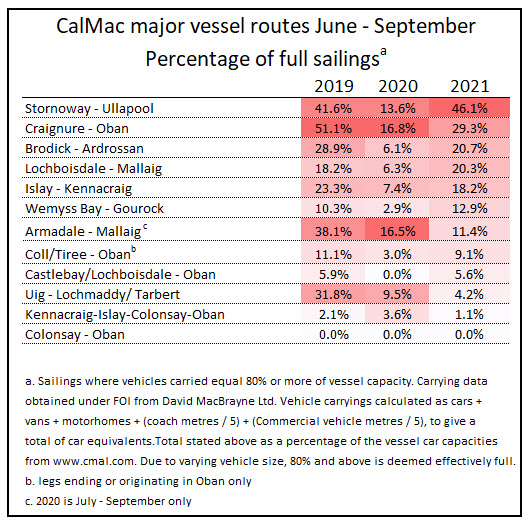
2 Hull 802, destined for services across the Minch from Uig. When this new ferry finally arrives perhaps in 2023, it will replace the MV Hebrides operating two separate services; one to Harris and the other to North Uist. Again, local community groups and ferry industry experts had advocated for two vessels, which would have:
- Improved the timetable hugely, both in convenience / connectivity and frequency
- Improved redundancy, reducing the need for breakdown or annual service to be covered by removing vessels from other routes
- Cheaper and easier to implement, by not requiring expensive and intrusive pier enlargement
- Improved network resilience by adding an additional vessel to the fleet
- Been cheaper to deliver, both in vessel and port costs
- Had no net increase in operating cost

Instead, 802 was chosen. She will bring a vehicle capacity increase of 40%, but little else. No timetable improvement, no extra sailings, no improvement to redundancy and no improvement to network resilience. Additionally to accommodate this huge vessel, all three ports of Uig, Lochmaddy and Tarbert are having to be deepened and enlarged for further tens of millions of pounds – and in the process Uig will be closed entirely for six months. It’s a very high price to pay in all respects, before even considering the cost of the vessel.
Don’t repeat the same mistakes on Mull
As we approach the replacement of our own MV Isle of Mull, there is understandable concern on our islands that CMAL’s preference for large ferry ‘cruise liners’, will be repeated on Mull.
Side note – Islay’s ferries are Islay’s business, and we have no desire to interfere with the wishes of the Islay community on this. They are having much-needed new ferries delivered, and that is to be welcomed. It is for that reason that we have witheld from publishing this piece until the NIF contract was awarded.
Outside of the operational and commercial disadvantages of these huge ships, they would be particularly unsuited to the Oban-Craignure route – firstly because Mull’s predominantly single-track roads could not cope with huge influxes of 100+ vehicles in one batch; and secondly because the route suffers from poor weather-reliability as a result of these large slab-sided vessels being unable to berth in high winds. (for more on that, see here)
So we have looked at the handling of the NIF ferry program with some consternation – because yet again, CMAL appear to have pushed ahead with the largest option on the table, and have used a questionable ‘consultation’ to denigrate the alternative – a pair of smaller ferries. It looks like the same strategy as deployed for Loch Seaforth and 802 is being applied again to Islay. Mull and Iona are next in line.
The slides below are an abbreviated version of the consultation document used by CMAL in their webinar of January 14th 2021. (The original presentation videos and documents can be found here.) In the document below we have added our own notes to critique CMAL’s presentation. You will see CMAL’s errors, assumptions, misrepresentations and omissions that heavily skew the outcome away from choosing two small ferries, and toward one single large one. (If you’d rather view it as a pdf, click here)
As you will have seen from the slides above, there is a long list of errors, omissions and mis-representations in CMAL’s options assessment.
- An assumption was made that all vessel options, regardless of size, had a ‘requirement’ for a crew of of 27. This is not just absurd, but immediately biases the assessment in favour of the larger vessel. There are examples in CalMac’s own fleet of more productive crewing – for example the MVs Argyle and Bute, which have the same vehicle and car capacity as the small vessel options in the Islay assessment – yet they have a crew of just 12. Argyle and Bute have a different operating classification and reduced on-board catering, but that cannot account for the Islay vessels having a ‘requirement’ for a crew of 27, more than twice the Argyle and Bute pair.
- Calculation of fuel consumption per car space was arithmetically incorrect, again biasing the larger vessel. Even if we accepted CMAL’s highly simplistic calculation of fuel consumption per car space (we don’t), we cannot accept basic arithmetical errors and inconsistency. The car capacities used in the ‘fuel consumption per car space’ calculations are stated as 7 car spaces fewer than CMAL’s own car deck plans demonstrate. This leads to erroneous fuel consumption declarations that inflate the fuel consumption advantage of the larger vessel.
- Fuel consumption calculations were so crude as to be meaningless, and took no account of the ability of two smaller vessels to operate a more efficient timetable. Any competent assessment of the comparative fuel costs of two different vessel options would take account of the timetable variations that those alternatives would enable. Self-evidently, two vessels are far more flexible than one, with greater opportunity to adjust timetable frequency and operating hours to match demand. For example, at times of day with low demand, just one vessel can operate instead of two; and by adjusting the number of sailings operated by each vessel through the year, route capacity can track demand more accurately. By contrast, one large ferry is less flexible, with less ability to match available spaces to the number of vehicles wishing to travel. In short, the large vessel will operate with many more unused car spaces through the year than two smaller ones could have. So CMAL’s simplistic “fuel consumption divided by total car spaces” calculation is hopelessly crude for what should be a critical and nuanced assessment.
- Comparison of HGV carrying capacity was selective and favoured the larger vessel, even though its HGV weight capacity was lower than the combination of two smaller vessels. This is very obvious use of selective information. On one page, the HGV capacity of each option references a truck weight of 44 tonnes (the maximum road-legal limit, and the weight of spirit tankers, such as those commonly using the Islay ferry); yet on another, truck weights of just 34.5 tonnes are used. This obscured the fact that the pair of smaller vessels could collectively carry one more 44t truck than the chosen ‘option 2’.
- The presentation claimed a longer operating day for the smaller vessels due to their slower speed; but failed to account for the faster turnaround they could offer. Again, apparent bias against the small vessel option failed to take account of the quicker turnaround that a small vessel (without a mezzanine deck) could achieve. They chose to only look at the service speed.
- There was no account of the increased timetable frequency that two smaller vessels could offer. For users, this is a major benefit that went completely unaccounted for. Increased frequency means more opportunities to arrive and depart, greater flexibility and less waiting time between sailings. It went completely unmentioned in the comparative ratings of the vessel options.
- There was no account of the increased network resilience that two smaller vessels could offer, nor of their ability to operate to more ports than the large vessel. ‘Network resilience’ is regularly cited by CalMac, CMAL and Transport Scotland as a key requirement of vessel design, yet this criterion was also completely absent from the comparative ratings table. Two small vessels give greater resilience (obviously) because there are two of them. If a vessel has to be re-deployed, it can be done with less impact on the service it is ‘borrowed’ from. Not only that, but the smaller vessels would have had both a shallower draught and have been narrower – meaning that they could have berthed at more ports in the network. The chosen ‘option 2’ vessel can only operate to a limited number of ports (and only after three of them have been lengthened and deepened), and for some of the ports it can access, it can only do so stern-in.
- There was an inexplicable assertion that two smaller vessels would cost more than one large one. There is absolutely no evidence to support this in CMAL’s document, just an assertion that this is so. We can cast credible doubt on this assertion by looking at a recent example. Finlaggan cost £40 million (adjusted for inflation); but she is 15 metres longer than the small vessels assessed for Islay, and also carries 30 more cars. Bute and Argyle cost £14 million (also at 2022 prices). They are the same size and capacity as the proposed Islay vessels, but have a lower certification rating. With those two benchmarks (validated by the opinions of professionals we have consulted), we suggest a build cost estimate of £30 million each is more than reasonable. The total cost of one large ‘option 2’ vessel as chosen by CMAL was £67 million (including port upgrade costs). Two small ‘option 3’ vessels could have cost 2 x £30m = £60 million. This is based on the known build costs of previous CMAL designs, before considering if more cost-effective designs might be available – something we will return to later.
- No account was taken of the ability of two smaller vessels to provide a longer operating day by overlapping timetables. This is another critical benefit to islanders that went completely un-measured in CMAL’s analysis. But Islanders could have been offered an earlier start to the operating day, and a later finish, simply by over-lapping the services of each small vessel. Another missed opportunity.
What could Islay have had?
Ultimately, CMAL have awarded a contract to build two x large ‘option 2’ ships, to replace both the Finlaggan and the Hebridean Isles. The original intention was to replace just the Hebridean Isles and retain the Finlaggan. The logical outcome of opting for the smaller ‘option 3’ vessels to replace both the Finlaggan and the Hebridean Isles would have been to build four ‘option 3’ vessels. Let’s look at what that choice could have delivered.
| 2 x CMAL ‘s chosen ‘option 2’ | 4 x CMAL’s rejected ‘option 3’ | |
| Vessel length | 94.8m | 70-75m |
| Draught | 3.8-4.0m | 3.0-3.4m |
| Cargo capacity | 2 x 484t = 968t | 4 x 264t = 1056t |
| HGV capacity | 28 x 34.5t / 22 x 44t | 28 x 38t / 24 x 44t |
| Car Capacity | 2 x 107 = 214 | 4 x 57 = 228 |
| Sailings per day | 2 x 5 = 10 | 4 x 5 = 20 |
| Total daily car capacity | 1070 | 1140 |
| Total daily HGV capacity | 110 x 44t | 120 x 44t |
| Crew* | 2 x (2.2 x 27) = 120 | 4 x (2.2 x 14) = 123 |
| Port upgrade costs | £17m | £0 |
| Build cost | £105m | 4 x £30 million estimate |
| Total cost | £122m | £120m |
| Redundancy | MEDIUM. 50% loss of service from one breakdown | HIGH. 25% loss of service from one breakdown. |
| Timetable Frequency | MEDIUM. Maintains existing TT | HIGH. Doubles frequency. |
| Length of operating day | MEDIUM. Works existing 14 hour day. | HIGH. More opportunity to overlap timetables, with earlier start and later finish |
| Network Resilience | MEDIUM. No increase in number of vessels, and large vessels cannot operate to all ports. | HIGH. Brings two additional vessels into the fleet, and all four vessels capable of operating to all ports in network. |
Operating costs (crew and fuel) are likely to be very similar for both options, but without more detail on the design of option 3 nor the timetable they would operate, it is not possible to calculate precise operating costs.
So, Islay and the wider network have missed out on a doubling of service frequency, an increase in HGV capacity by 9%; and an increase in car capacity by 6%. The whole network has missed out on the extra resilience and redundancy that two additional vessels could have brought. All of these benefits could even have been delivered for a slightly lower capital cost to the taxpayer.
And it doesn’t end there….
It’s not just the choice of vessel size and type that is problematic here, but the way in which the design of the vessel ultimately chosen was arrived at. A tendering process that was built around a competition to find the best way to meet the requirements of users and taxpayers could yield a far better design, particularly in terms of capital and operating costs. On the left are two vessels from the Norwegian Lofoten Islands, one in operation, and the other just announced. The new Lofoten ferry is being built in the same Turkish shipyard as the new Islay ferries, at the same time – but will be costing as little as half as much. On the right, we have the new Islay ferry, and one of her predecessors, the Finlaggan. There is symmetry here – the Finlaggan was also built in the same shipyard as its Norwegian counterpart, the Landegode.




| Landegode | New Lofoten Ferry | Finlaggan | New Islay Ferry | |
| Size (length/beam/ draught) | 96m/17m/4.2m | 117m/17m/5.0m* | 89.8m/16.3m/3.4m | 94.8m/18.7m/4.0m |
| Launch | 2012, Remontowa Poland | 2023, Cemre Turkey | 2011, Remontowa Poland | 2023, Cemre Turkey |
| Cost (2022 prices) | £22.6 million (one of a series of 4) | £26 – £31 million | £40 million | £52.5m (one of a series of 2) |
| Propulsion | LNG | Full Electric | Marine Diesel | Diesel-Electric |
| Car capacity | 120 | 120 | 85 | 107 |
| Passengers | 390 | 399 | 550 | 350 |
| Onboard Crew | 12 | 11 | 29 | 27 |
| Daily operating hours | 20 | 20 | 14 | 14 |
The Landegode was built for the Norwegian ferry operator Torghatten Nord, as the central part of their competitive bid for the government contract to run services to the Lofoten islands. The new Lofoten ferry will be deployed to another route slightly further North with a 60 minute crossing time, also operated by Torghatten. Norwegian ferry routes are put out to tender individually, rather than as one large network as is the case in Scotland. Government specify the requirements, in terms of timetable, capacity, and other key requirements like emissions levels. Private ferry operators then bid, with their offers assessed on the basis of service and cost.
(For more on the topic of ‘un-bundling’ see here)
For the Norwegian ferry operator therefore, there is a huge interest in building their vessels economically, and operating them efficiently, so that they have a competitive advantage at tendering time. Designers have the challenge of meeting a brief that delivers the best service for the best price – and as can be seen above, the outcome is remarkably better in three key respects:
1 Build cost. Both of the Norwegian examples cost around half of their CMAL equivalents. The contrast between the new Lofoten ferry and the new Islay ferry is most striking, since they are being build beside one-another in the same shipyard. Also worth noting that the Landegode is LNG powered, ten years before CMAL moved in that direction with 801 and 802. Similarly, the new Lofoten ferry is entirely battery-electric, years before CMAL have anything similar on the drawing board. Compared with their Norwegian equivalents, both the Finlaggan and the New Islay Ferry are a) complex designs with lots of cabins to accommodate, and b) one-off builds to a unique design. The price differential may also have something to do with CMAL’s habit of publishing what they expect to pay for a vessel before asking for tenders. Or more likely, its a mixture of all three.

2 Crew numbers. Norway is subject to very similar maritime safety laws as Scotland, observes the EU Working Time Directive like Scotland. The Norwegian vessels are operating on long crossings (1 hour for the New Lofoten Ferry, 4 hours for the Landegode) in very exposed seas above the Arctic circle. Yet both are able to operate with crews of between 11-12. This is purely as a result of a ship design that has been optimised for efficiency of operation. Measures such as a) optimisation of emergency evacuation equipment b) automation of mooring equipment (fewer ropes) c) Pared-down catering offer with more prep ashore d) A single passenger deck with a single muster station e) Passenger certification more closely matched to passenger carryings.
3 Operating hours. Not only can both Norwegian examples operate with less than half the crew of the New Islay Ferry, they operate for 20 hours every day – ie around 50% longer. So she can operate more services every day, carrying more people and vehicles. In total, the Norwegian vessels are three times more productive, in terms of operating hours per crew member. If the same kind of regime was adopted for Islay, an additional 2 sailings could be operated each day. Or on Mull, we could have 9 return trips (instead of five) from 6am till midnight every day, all from one vessel.
Scottish ferry services could be SO much better, and we hope that we’ve illustrated in this article how they could be improved. As exampled by Islay, the ferry procurement system remains dysfunctional, and the appalling failure of the 801/2 process seems to have had little influence.
We have focussed on CMAL’s role in the process, but they are just one of three organisations who determine what our ferry service looks like. CMAL have made such obvious errors with their procurement process, that one has to ask who in Transport Scotland was checking their work. And CalMac are not blameless here either – it is they who provide a ‘Specfication of Operational Requirements’ for each new vessel, from which CMAL create a vessel design. It is CalMac who settled on a crew ‘requirement’ of 27, for example. But who is it that ‘requires’ the vessel to operate with crewing that is so much higher than other operators need?
We will touch on that and more in part two of our examination of the Islay procurement process, to be published in the week beginning April 18th.
<<<<<<<<<<<<<<<<<<<<<<<<>>>>>>>>>>>>>>>>>>>>>>>>>>
Acknowledgements and sources
We are grateful for the expertise and advice of many industry experts in creating this article, including Alf Baird and Roy Pedersen. We have also had essential contributions from practicing, retired and teaching naval architects in the UK and abroad; ship brokers, ship managers, financiers, ferry operators, and numerous Scots close to the subject. Thank you to all of them.
If you have any questions on the subject, would like to see our source material or have any contributions of your own, please do get in touch by emailing us.

